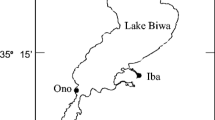Abstract
Intra-clutch egg size variation was studied in SwallowsHirundo rustica in central Poland during two breeding seasons differing very much with respect to weather conditions. No correlation between egg volumes, lengths or breadths and the egg laying order was found. In one season (with high mean temperature and low precipitation) the final egg tended to be larger than the mean size of the preceding eggs in the clutch. Such a difference was not observed in the other season (with low mean temperature and high precipitation). This fact seemed to be connected with a general impact of weather conditions prevailing in each year on the breeding ecology of Swallows. There was no evidence for an expected short-term effect of temperature on egg size. All this suggests that the relation between proximate and ultimate factors affecting egg size variation may be very complex.
Zusammenfassung
In Zentalpolen wurde die Variation der Eidimensionen innerhalb eines Geleges bei der Rauchschwalbe in zwei Brutperioden untersucht. Die beiden Jahre unterschieden sich in den Witterungsverhältnissen stark voneinander. Zwischen Eivolumen, -länge und -breite und der Legefolge wurden keine Korrelationen gefunden. In einer Brutsaison (hohe Mitteltemperaturen und geringe Niederschläge) war das letzte Ei eines Geleges tendenzielll größer als das Mittel der vorher gelegten Eier. Ein derartiger Unterschied ließ sich in der anderen Brutsaison (niedrige Mitteltemperaturen, hohe Niederschläge) nicht feststellen. Dies scheint mit generellen Folgewirkung des jeweils vorherrschenden Wetters zusammenzuhängen. Ein Kurzzeiteffekt der Temperatur auf die Eigröße ließ sich wider Erwarten nicht nachweisen. Die Befunde deuten an, daß für die Variation der Eigröße verantwortlichen unmittelbaren und mittelbaren Faktoren sehr komplex sind.
Similar content being viewed by others
Literature
Arnold, T. W. (1991): Intraclutch variation in egg size of American Coots. Condor 93: 19–27.
Banbura, J. (1986): Sexual dimorphism in wing and tail length as shown by the Swallow,Hirundo rustica. J. Zool., Lond. 210: 131–136.
Bancroft, G. T. (1984): Patterns of variation in size of Boat-tailed GrackleQuiscalus major eggs. Ibis 126: 496–509.
Bryant, D. M. (1978): Environmental influences on growth and survival of nestling House MartinsDelichon urbica. Ibis 120: 271–283.
Clark, A. B., &D. S. Wilson (1981): Avian breeding adaptations: hatching asynchrony, brood reduction, and nest failure. Q. Rev. Biol. 56: 253–277.
Greig-Smith, P. W., C. J. Feare, E. M. Freeman &Spencer, P. L. (1988): Causes and consequences of egg-size variation in the European StarlingSturnus vulgaris. Ibis 130: 1–10.
Haftorn, S. (1986): Clutch size, intraclutch egg size variation, and breeding strategy in the GoldcrestRegulus regulus. J. Orn. 127: 291–301.
Howe, H. F. (1976): Egg size, hatching asynchrony, sex, and brood reduction in the Common Grackle. Ecology 57: 1195–1207.
Järvinen, A., &Ylimaunu, J. (1986): Intraclutch egg-size variation in birds: Physiological responses of individuals to fluctuations in environmental conditions. Auk 103: 235–237.
Jover, L., X. Ruiz &M. Gonzalez-Martin (1993): Significance of intraclutch egg size variation in the Purple Heron. Ornis Scand. 24: 127–134.
Kendeigh, S. C. (1941): Length of day and energy requirements for gonad development and egg-laying in birds. Ecology 22: 237–248.
Lowther, P. E. (1990): Breeding biology of House Sparrows: Patterns of intra-clutch variation in egg size. In:J. Pinowski &J. D. Summers-Smith, Granivorous Birds in the Agricultural Landscape: 137–149. Warszawa.
Magrath, R. D. (1992): Seasonal changes in egg-mass within and among clutches of birds: general explanations and a field study of the BlackbirdTurdus merula. Ibis 134: 171–179.
Manning, T. H. (1979): Density and volume corrections of eggs of seven passerine birds. Auk 96: 207–211.
Møller, A. P. (1994): Sexual Selection and the Barn Swallow. Oxford.
Ojanen, M. (1983): Effects of laying sequence and ambient temperature on the composition of eggs of the Great TitParus major and the Pied FlycatcherFicedula hypoleuca. Ann. Zool. Fennici 20: 65–71.
Ditto,M. Orell &R. A. Väisänen (1981): Egg size variation within passerine clutches: effects of ambient temperature and laying sequence. Ornis Fennica 58: 93–108.
Pinowska, B. (1979): The effect of energy and building resources of females on the production of House Sparrow (Passer domesticus [L.]) populations. Ekol. Pol. 27: 363–396.
Potti, J. (1993): Environmental, ontogenetic, and genetic variation in egg size of Pied Flycatchers. Can. J. Zool. 71: 1534–1542.
Robertson, G. J., &F. Cooke (1993): Intraclutch egg-size variation and hatching success in the common eider. Can. J. Zool. 71: 544–549.
Rofstad, G., &J. Sandvik (1985): Variation in egg size of the Hooded CrowCorvus corone cornix. Ornis Scand. 16: 38–44.
Ryden, O. (1978): Egg weight in relation to laying sequence in a south Swedish urban population of the BlackbirdTurdus merula. Ornis Scand. 9: 172–177.
Slagsvold, T., &J. T. Lifjeld (1989): Constraints on hatching asynchrony and egg size in Pied Flycatchers. J. Anim. Ecol. 58: 837–849.
Slagsvold, T., J. Sandvik, G. Rofstad, O. Lorentsen &M. Husby (1984): On the adaptive value of intraclutch egg-size variation in birds. Auk 101: 685–697.
Sokal, R. R., &F. J. Rohlf (1981): Biometry. New York.
Turner, A. K. (1994): The Swallow. London.
Wiggins, D. A. (1990): Sources of variation in egg mass of Tree SwallowsTachycineta bicolor. Ornis Scand. 21: 157–160.
Williams, T. D. (1994): Intraspecific variation in egg size and egg composition in birds: effects on offspring fitness. Biol. Rev. 68: 35–59.
Winkel, W. (1970): Experimentelle Untersuchungen zur Brutbiologie von Kohl-und Blaumeise (Parus major undParus caeruleus). J. Orn. 111: 154–174.
Zach, R. (1982): Hatching asynchrony, egg size, growth, and fledging in Tree Swallows. Auk 99: 695–700.
Zar, J. H. (1984): Biostatistical Analysis. Englewood Cliffs.
Author information
Authors and Affiliations
Rights and permissions
About this article
Cite this article
Bańbura, J., Zieliński, P. The influence of laying sequence and ambient temperature on egg size variation in the SwallowHirundo rustica . J Ornithol 136, 453–460 (1995). https://doi.org/10.1007/BF01651593
Issue Date:
DOI: https://doi.org/10.1007/BF01651593



